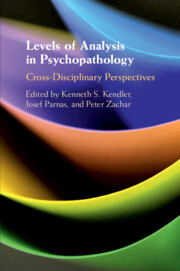Book contents
- Levels of Analysis in Psychopathology
- Advance Praise for Levels of Analysis in Psychopathology
- Levels of Analysis in Psychopathology
- Copyright page
- Contents
- Figures
- Tables
- Contributors
- Preface
- General Introduction
- Part I Neuroscience, Mechanisms, and RDoC
- Part II Phenomenology, Biological Psychology, and the Mind–Body Problem
- Part III Taxonomy, Integration, and Multiple Levels of Explanation
- Section 8
- Section 9
- Section 10
- Section 11
- 31 Introduction
- 32 Approaches to Multilevel Models of Fear: The What, Where, Why, How, and How Much?
- 33 Schaffner on Levels and Selves
- Section 12
- Section 13
- Section 14
- Section 15
- Index
- References
33 - Schaffner on Levels and Selves
from Section 11
Published online by Cambridge University Press: 02 April 2020
- Levels of Analysis in Psychopathology
- Advance Praise for Levels of Analysis in Psychopathology
- Levels of Analysis in Psychopathology
- Copyright page
- Contents
- Figures
- Tables
- Contributors
- Preface
- General Introduction
- Part I Neuroscience, Mechanisms, and RDoC
- Part II Phenomenology, Biological Psychology, and the Mind–Body Problem
- Part III Taxonomy, Integration, and Multiple Levels of Explanation
- Section 8
- Section 9
- Section 10
- Section 11
- 31 Introduction
- 32 Approaches to Multilevel Models of Fear: The What, Where, Why, How, and How Much?
- 33 Schaffner on Levels and Selves
- Section 12
- Section 13
- Section 14
- Section 15
- Index
- References
Summary
Two concepts figure prominently in Schaffner’s discussion of LeDoux’s account of fear and anxiety: level and self. With respect to level, I differentiate two conceptions of levels invoked in his account: levels of hypotheses (high-level and intermediate-level instantiations) and mechanistic levels involving components within mechanisms. Both are important for Schaffner’s purposes, but they operate differently and should be distinguished. Schaffner’s account of self focuses on personality, but I suggest that more relevant is how one represents oneself, including one’s personality. I develop Neisser’s account of five types of knowledge one might have about oneself and argue that Neisser’s conceptual self is of the most use in understanding LeDoux’s account of fear. I conclude by suggesting how the representation of oneself may be developed differently at different levels of theorizing about oneself.
- Type
- Chapter
- Information
- Levels of Analysis in PsychopathologyCross-Disciplinary Perspectives, pp. 410 - 418Publisher: Cambridge University PressPrint publication year: 2020

